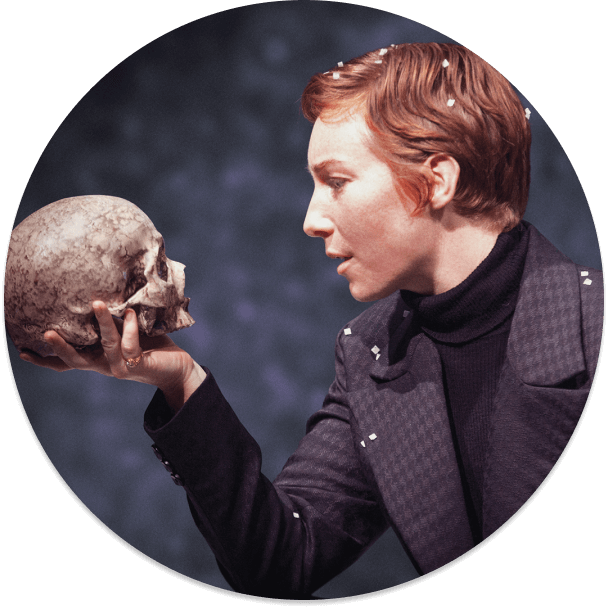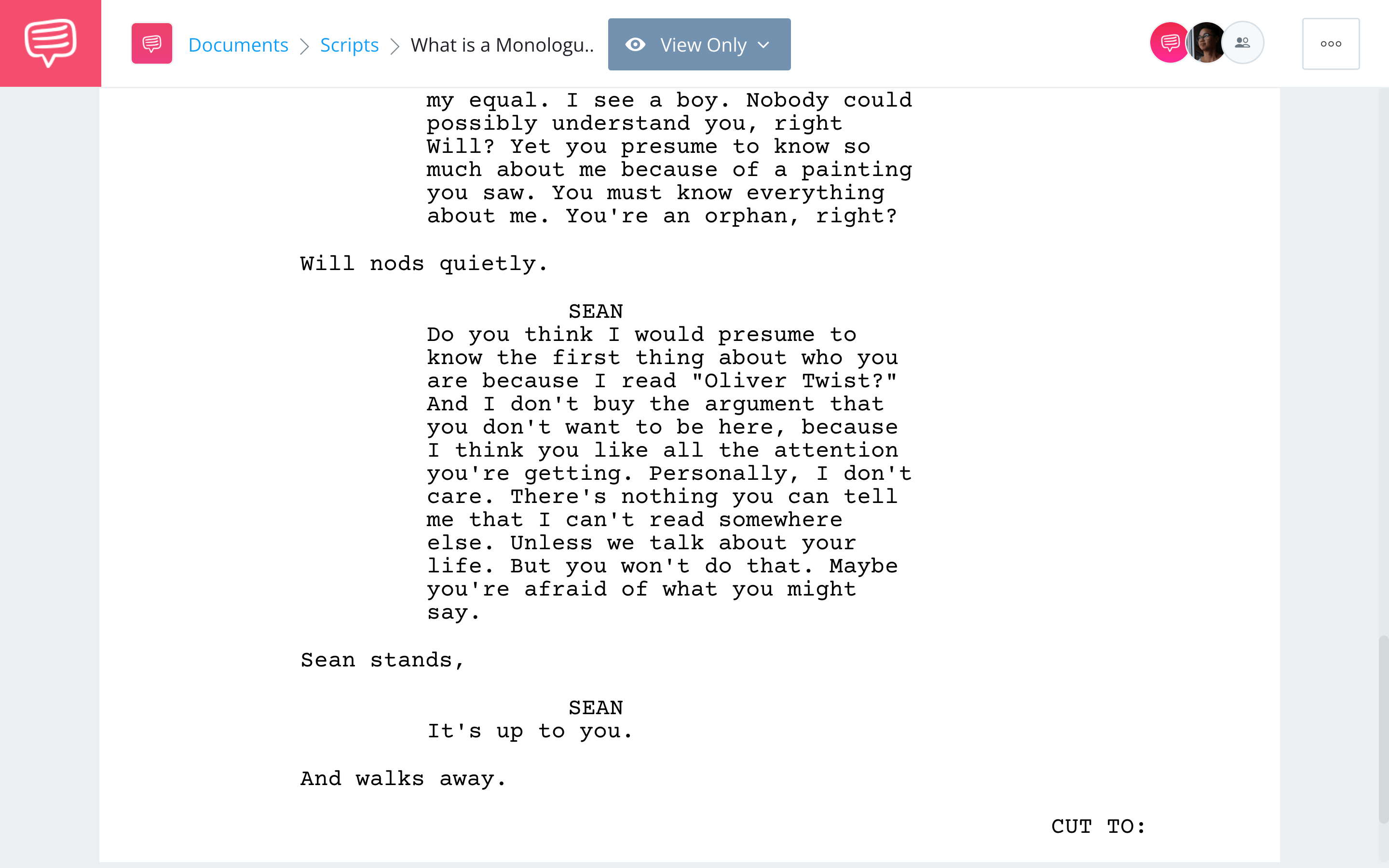Some of the most iconic lines in the history of literature and cinema have come from monologues. As a character spills their thoughts and emotions into a speech, they often create memorable lines that connect to characters and the audience. In this article, we’ll take a look at some iconic monologues and analyze what exactly a monologue is. We’ll also take a look at the three types of monologues with examples of each. Let’s dive in.
What is a Monologue
First, let’s define monologue
Screenwriting is a skill but writing dialogue is an art unto itself. What writer wouldn't want to indulge in a flowing and expansive speech? Well, as most writing teachers will tell you, this is an indulgence one should only partake in when necessary. A successful monologue, in other words, is a strategic one.
Before we take a look at writers craft monologues, let’s take a look at the monologue definition to get a better understanding of their purpose.MONOLOGUE DEFINITION
What is a monologue?
A monologue is a long form speech delivered by a single character in a play or a film. The term monologue derives from the Greek words “monos” which translates to “alone” and “logos” which means “speech.” These speeches are used by writers to express a character’s thoughts, emotions, or ideas. Depending on what type of monologue is used, the character can be addressing themself, another character, or the audience.
Types of Monologues:
- Soliloquy
- Dramatic
- Internal
What is a Monologue Used For?
What is the purpose of a monologue
A story is made up of bits of information that is communicated to the audience over time. When it comes to information regarding a character’s thoughts or emotions, a monologue is effective at efficiently communicating this info to the audience and/or to another character.
A monologue is often the vocalization of a character’s thoughts giving insight that reveals details about a story’s plot or its characters. This character’s speech in and of itself can propel the story forward based on how other characters react to it and what events are caused by it.
A great example of this can be found in the Good Will Hunting script. Will (Matt Damon) is resistant to any court mandated therapist. However, this monologue by Sean (Robin Williams) caused Will to finally be open to meeting further with him.
We brought the iconic monologue into StudioBinder's screenwriting software to analyze it further. Click the image below to read the entire scene. With writing this good, no wonder this script won the Oscar.
Good Will Hunting script • Read the entire scene
As you can see, this monologue does multiple things simultaneously for the film’s story. It reveals exposition about Sean. We learn he is a veteran, that he loved his wife deeply, and that he lost his wife to cancer.
At the same time, the monologue propels the plot forward by allowing Sean to finally break through to Will.
Good monologues will either reveal character information or plot info. A great monologue will reveal both while moving the story forward all at the same time. Let’s take a look at the different types of monologues you can use in your own work.
Related Posts
What is a Monologue in Literature and Film?
Types of Monologues
It is important to understand the type of monologues and their unique properties. There are three different types of monologues that are all defined by who the monologue is delivered to. Who the monologue is delivered to also influences the content of the monologue.
Soliloquy
What is the difference between a monologue and a soliloquy? This is a great place to start. A soliloquy is a type of monologue in which a character delivers a long speech to themself rather than to another character or to the audience. In a way, a soliloquy is a character talking to themself trying to analyze their own thoughts, emotions, or predicament.
One of the most famous excerpts from any play in history is in fact a soliloquy from Shakespeare’s Hamlet. In this iconic soliloquy, sometimes known as the to be or not to be monologue Hamlet ponders life and death and whether the hardships of life are too difficult to manage.

To be, or not to be, that is the question:
Whether 'tis nobler in the mind to suffer
The slings and arrows of outrageous fortune,
Or to take arms against a sea of troubles
And by opposing end them. To die—to sleep,
No more; and by a sleep to say we end
The heart-ache and the thousand natural shocks
That flesh is heir to: 'tis a consummation
Devoutly to be wish'd. To die, to sleep;
To sleep, perchance to dream—ay, there's the rub:
For in that sleep of death what dreams may come,
When we have shuffled off this mortal coil,
Must give us pause—there's the respect
That makes calamity of so long life.
For who would bear the whips and scorns of time,
Th'oppressor's wrong, the proud man's contumely,
The pangs of dispriz'd love, the law's delay,
The insolence of office, and the spurns
That patient merit of th'unworthy takes,
When he himself might his quietus make
With a bare bodkin? Who would fardels bear,
To grunt and sweat under a weary life,
But that the dread of something after death,
The undiscovere'd country, from whose bourn
No traveller returns, puzzles the will,
And makes us rather bear those ills we have
Than fly to others that we know not of?
Thus conscience doth make cowards of us all,
And thus the native hue of resolution
Is sicklied o'er with the pale cast of thought,
And enterprises of great pith and moment
With this regard their currents turn awry
And lose the name of action.
— Hamlet
From this monologue example, you can see that soliloquies are often the most genuine and honest because a character is talking to themself and has no reason to lie. So the reliability behind the monologue is not questioned by the audience.
Related Posts
Dramatic monologue
A monologue that is delivered by a character to another character or to the audience is defined as a dramatic dialogue. Dramatic dialogues are long in length and often unbroken by the speech of other characters.
These are the most common monologues found in film since characters deliver monologues mainly to other characters. While dramatic monologues in both film and plays are commonly delivered to other characters, they can also be delivered directly to the audience if the fourth wall is broken.
One of the best movie monologues from Call Me By Your Name is a showstopper. Delivered by a pitch-perfect Michael Stuhlbarg, this speech has everything you’d want in a monologue. It feels natural yet important, and it is informed both by the reactions of Elio and Mr. Perlman’s own internal struggles. Give it a watch:
Call Me By Your Name • a monologue from a movie
Internal monologue
An internal monologue is a type of monologue in which a character’s thoughts are expressed but not vocalized in the world of the story. In literature, this is often expressed in italicized paragraphs to indicate that the words are not spoken out loud. In a play, this can be delivered as an aside. In film, an internal monologue is delivered through voice over as a way for the audience to witness the thoughts of a character.
This brilliant internal monologue from one of Charlie Kaufman’s best films Adaptation gives us insight into what the character is thinking. This is then immediately and ironically ridiculed by the speaker in the scene.
McKee monologue
Adaptation Monologue Example • Read Full Scene
Like the irony underscores in the scene, internal monologues and voice over can be dangerous and ineffective when used as a crutch. But when used cleverly as it is in this example by Charlie Kaufman, it can elevate the creativity of a film and how it connects to an audience.
Related Posts
Up Next
How to Write ‘Realistic’ Dialogue
Monologues in film are most commonly delivered within a larger dialogue scene. A part of creating a memorable monologue is by writing great dialogue that frames it. In our next article, we lay out some fundamental tips to writing realistic, compelling dialogue.



I loved it .I wish to write one
wow!
Wonderful!!
This is a good idea